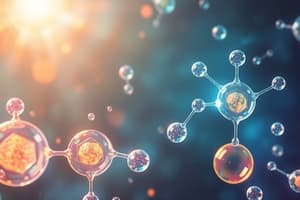Podcast
Questions and Answers
What are hydrocarbon derivatives primarily defined as?
What are hydrocarbon derivatives primarily defined as?
- Compounds derived from hydrocarbons by adding hydrogen atoms
- Compounds derived from hydrocarbons by replacing one or more hydrogen atoms with functional groups (correct)
- Pure hydrocarbons without any functional groups
- Compounds that are exclusively hydrocarbons
Which of the following is an example of an amide?
Which of the following is an example of an amide?
- Ethanol (C2H5OH)
- Acetamide (CH3CONH2) (correct)
- Acetic acid (CH3COOH)
- Chloroform (CHCl3)
What functional group is characteristic of carboxylic acids?
What functional group is characteristic of carboxylic acids?
- Hydroxyl group (-OH)
- Carbonyl group (C=O)
- Aldehyde group (C=O)
- Carboxyl group (-COOH) (correct)
Which type of hydrocarbon derivative is known for containing a carbonyl group at the end of a carbon chain?
Which type of hydrocarbon derivative is known for containing a carbonyl group at the end of a carbon chain?
How do hydrocarbon derivatives generally differ from corresponding hydrocarbons?
How do hydrocarbon derivatives generally differ from corresponding hydrocarbons?
What type of reaction is NOT commonly associated with hydrocarbon derivatives?
What type of reaction is NOT commonly associated with hydrocarbon derivatives?
Which of the following hydrocarbon derivatives includes an oxygen atom connected to two alkyl or aryl groups?
Which of the following hydrocarbon derivatives includes an oxygen atom connected to two alkyl or aryl groups?
Why are hydrocarbon derivatives important in biochemistry?
Why are hydrocarbon derivatives important in biochemistry?
Flashcards are hidden until you start studying
Study Notes
Hydrocarbon Derivatives
-
Definition: Hydrocarbon derivatives are compounds derived from hydrocarbons by replacing one or more hydrogen atoms with functional groups.
-
Types of Hydrocarbon Derivatives:
- Halides: Compounds containing halogen atoms (F, Cl, Br, I).
- Example: Chloroform (CHCl3).
- Alcohols: Compounds with one or more hydroxyl (-OH) groups.
- Example: Ethanol (C2H5OH).
- Ethers: Compounds with an oxygen atom connected to two alkyl or aryl groups.
- Example: Diethyl ether (C2H5)2O.
- Aldehydes: Compounds with a carbonyl group (C=O) at the end of a carbon chain.
- Example: Formaldehyde (HCHO).
- Ketones: Compounds with a carbonyl group situated within the carbon chain.
- Example: Acetone (CH3COCH3).
- Carboxylic Acids: Compounds containing a carboxyl group (-COOH).
- Example: Acetic acid (CH3COOH).
- Esters: Derivatives of carboxylic acids where the hydroxyl group is replaced by an alkoxy group (-O-alkyl).
- Example: Ethyl acetate (CH3COOCH2CH3).
- Amines: Compounds derived from ammonia (NH3) by substituting hydrogen atoms with alkyl or aryl groups.
- Example: Methylamine (CH3NH2).
- Amides: Compounds formed from carboxylic acids and amines.
- Example: Acetamide (CH3CONH2).
- Halides: Compounds containing halogen atoms (F, Cl, Br, I).
-
Properties:
- Vary widely depending on the functional groups present.
- Generally exhibit different polarities, boiling points, and solubilities compared to corresponding hydrocarbons.
-
Reactivity:
- Functional groups dictate the chemical reactivity and interactions of hydrocarbon derivatives.
- Common reactions include substitution, addition, and elimination reactions.
-
Importance in Biochemistry:
- Serve as the building blocks for more complex biomolecules (e.g., amino acids, nucleotides).
- Play critical roles in metabolic pathways and cellular functions.
-
Applications:
- Used in pharmaceuticals, agricultural chemicals, and industrial processes.
- Serve as solvents, reagents, and intermediates in chemical synthesis.
-
Biochemical Relevance:
- Understanding hydrocarbon derivatives is essential for studying metabolic processes, enzyme functions, and the synthesis of biomolecules.
Hydrocarbon Derivatives Overview
- Hydrocarbon derivatives are compounds formed by replacing hydrogen atoms in hydrocarbons with functional groups.
Types of Hydrocarbon Derivatives
- Halides: Contain halogen atoms (F, Cl, Br, I); for example, chloroform (CHCl3).
- Alcohols: Feature hydroxyl (-OH) groups; ethanol (C2H5OH) is a common example.
- Ethers: Have an oxygen atom connecting two alkyl or aryl groups; diethyl ether ((C2H5)2O) is a well-known ether.
- Aldehydes: Possess a carbonyl group (C=O) at the end of a carbon chain; formaldehyde (HCHO) exemplifies this category.
- Ketones: Contain a carbonyl group within the carbon chain; acetone (CH3COCH3) is a typical ketone.
- Carboxylic Acids: Include a carboxyl group (-COOH); acetic acid (CH3COOH) is a primary example.
- Esters: Derivatives of carboxylic acids with an alkoxy group (-O-alkyl) replacing the hydroxyl; ethyl acetate (CH3COOCH2CH3) serves as an example.
- Amines: Derived from ammonia (NH3) by substituting hydrogen with alkyl or aryl groups; methylamine (CH3NH2) is a common amine.
- Amides: Formed from carboxylic acids and amines; acetamide (CH3CONH2) is a noted example.
Properties
- The properties of hydrocarbon derivatives vary significantly based on functional groups.
- These compounds typically exhibit different polarities, boiling points, and solubilities compared to their hydrocarbon precursors.
Reactivity
- Functional groups determine the chemical reactivity of hydrocarbon derivatives.
- Common reactions include substitution, addition, and elimination processes.
Importance in Biochemistry
- Hydrocarbon derivatives are building blocks for complex biomolecules such as amino acids and nucleotides.
- They play vital roles in metabolic pathways and various cellular functions.
Applications
- Widely used in the pharmaceutical industry, agricultural chemicals, and industrial applications.
- Function as solvents, reagents, and intermediates in chemical synthesis.
Biochemical Relevance
- Knowledge of hydrocarbon derivatives is crucial for understanding metabolic processes, enzyme functions, and biomolecule synthesis.
Studying That Suits You
Use AI to generate personalized quizzes and flashcards to suit your learning preferences.




